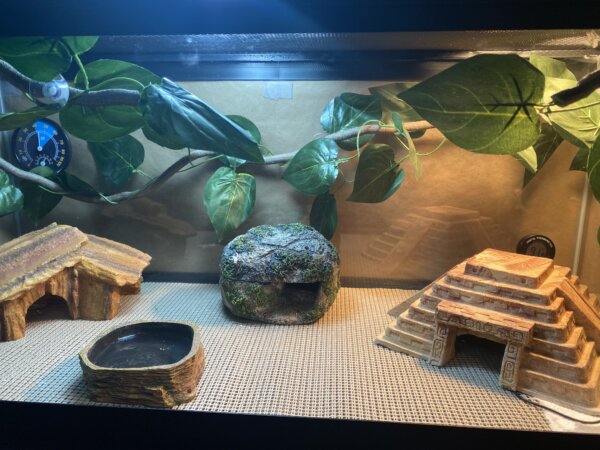
New Leopard Gecko Owner
Topics › Forums › Leopard Geckos › New Leopard Gecko Owner
- This topic has 3 replies, 4 voices, and was last updated 1 year, 5 months ago by
gvugarte.
-
AuthorPosts 1 Favorite
-
-
August 30, 2023 at 7:29 pm #103245
gvugarteParticipant
I need clarification on enclosure temperature gradient, heat sources, & feeding.
Login/Register To Reply
What is considered the ‘Basking Surface’? Is this the floor of the warm side or the surface of the hide on the warm side?
During the day on the warm side of my tank, a thermometer 2 inches from the floor reads 91 and inside the warm hide is 88. The surface of the warm hide can reach 97.
Does there need to be a heat source at night?
I only use a heat lamp and a UVA/UVB lamp during the day & turn them off at night. At night, the temperature in the tank does not drop below 67 degrees on the cool side and 73 on the warm side.
I’m in Florida and sun is up by 7am and goes down around 830pm. Lights mirror those times. According to when lights turn on, what would be the best times to feed?Attachments:
-
September 15, 2023 at 5:24 am #106159
LimbuParticipantIt sounds like you’re doing a great job with your new pet so far.
Basking surface: The basking surface is the area where your leopard gecko can bask and absorb heat. It can be the floor of the warm side of the tank, or a basking platform like a slate rock or piece of wood. The important thing is that the basking surface is at least 90 degrees Fahrenheit.
Heat sources at night: It’s not necessary to have a heat source on at night, as leopard geckos are nocturnal animals. However, if your house gets very cold at night, you may want to consider using a ceramic heat emitter or a low-wattage red light bulb.
Feeding times: In Florida, I would recommend feeding your leopard gecko around 7:30am and 8:30pm, just after the lights come on and before they go off. This will mimic their natural feeding schedule in the wild.
Here’s a tip: You can use the CapCut video editor to create a timelapse video of your leopard gecko’s enclosure temperature throughout the day and night. This can be a helpful way to visualize the temperature gradient and make sure that it’s within the ideal range.
Here are some additional tips for leopard gecko care:
Provide a variety of hides and enrichment items in the enclosure.
Use a good quality substrate, such as reptile carpet or paper towels.
Mist the enclosure regularly to keep the humidity up.
Feed your leopard gecko a diet of dusted crickets and mealworms.
Take your leopard gecko to the vet for regular checkups.
With proper care, your leopard gecko can live a long and happy life. -
October 10, 2023 at 9:50 pm #108204
cuhnkedrikParticipantSince leopard geckos are nocturnal, you don’t need to keep a heat source on at night. However, if you find that the temperature inside your home drops significantly after dark, you could benefit from installing a ceramic heat emitter or a low-wattage red light bulb.
In Florida, the best times to feed your leopard gecko are at 7:30 a.m. and 8:30 p.m., right when the sun rises and sets. This will be similar to how they eat in the wild. geometry dash
-
This reply was modified 1 year, 8 months ago by
cuhnkedrik.
-
October 13, 2023 at 8:31 am #108417
ericwillsonParticipantRecently hired Mechanical Estimating Services for my new leopard gecko’s vivarium setup. Their expert advice and precise estimates made the process hassle-free. Highly recommended for fellow gecko enthusiasts and anyone in need of reliable Mechanical services
-
This reply was modified 1 year, 8 months ago by
-
-
AuthorPosts
(adsbygoogle = window.adsbygoogle || []).push({});

